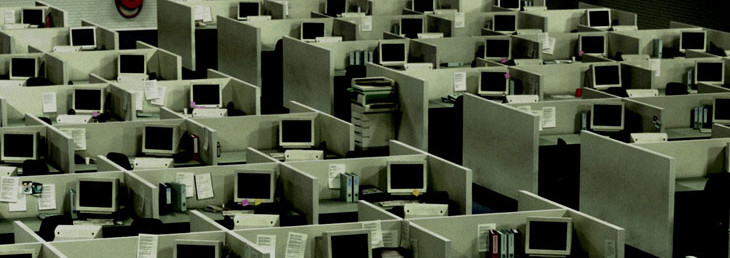Workplace should transit from a “me” to a “we” work environment

Organizations and companies are changing. Sometimes dramatically. Also is, consequently, workforce and the way it interacts within companies and with other organizations outside corporate walls. For sure, mobility and flexibility stand out as main forces molded by the emergent digital environment and businesses new needs. Arguably, collaboration comes next in the ranking of key elements shaping the workplace of the future.
Interest in how to foster collaboration is usually focused in tools and technologies, methodologies and even culture, elements that we could consider as the “software” of cooperation. But sometimes is wiser to start by the basics, pay more attention to how office spaces and furniture and their roles are determined, have a look first to the hardware in which support the software.
Some factors are not helping. The need for collaboration is growing while offices are shrinking and hot desking is becoming a common approach to the aforementioned flexibility. Organizations have been struggling for years to offer effective collaborative spaces, trying to find the balance between public and private workspace that best supports cooperation.
In the 80’s it was considered primordial to set up places in which was possible for everyone to concentrate without distractions and walled cubicles took over the corporate landscape. Later, the tide turned, and it began the current taste for open spaces and minimizing or even completely eliminating closed areas for privacy at work. A trend that is now again questioned by some experts and practices. Currently, many organizations recognize that their group spaces are underperforming, but do not know how to respond other than to add more variations.
Furniture is not trivial
Format and disposition of office furniture are not trivial. For instance, it is difficult for a rectangular table not to form a hierarchy when somebody is usually heading it. Same effect is caused when privacy spaces are only available to the highest ranks in the organization chart. On the other hand, casual lounge seating and tables promoting a range of postures and groupings reflect an informal nature of preferred interactions.
Things get even more complex when you consider not all collaboration is equal, but it comes in different types. Sometimes collaboration could just be informative when is only about sharing information and updates. This one is relatively straightforward. On the other hand, evaluative collaboration, the one that implies the need to make decisions, could be more complex to facilitate. Generative collaboration and its need for brainstorming, ideating and teeing ideas off each other needs a whole different kind of layouts.
Not limiting “collisions” to the watercooler area
Collaboration is influenced by the size and setup of office environments in many different ways. Powered by the certainty that the most creative ideas aren’t going to come while sitting in front of a monitor, many startups design their spaces to spark collaboration and innovation by making more likely for people to “collide”, advocating for open office plans that emphasize chance encounters. Innovation has been increasingly nurtured through informal, social, and creative interactions. Therefore, some companies are conforming spaces in order not to limit the chance of an informal innovation to the watercooler area, the only zone this could previously happen within.
Some demands on collaborative spaces go even further and besides supporting issues such as creativity and innovation aim to increase social connection and even building a sense of community. Indeed, a collaborative workplace can also perform as the building block for a more cohesive organization in which workers value to feel themselves as part of a community. This element explains, for instance, the growing network of coworking spaces in which connections with others are a key reason for users to pay for a communal space instead of working from home and saving the money. An engagement element that so many companies wished they could replicate at their own offices.
Creating collaborative Spaces that work
Knoll, the modern furniture design company for office and home, engaged Ratekin Consulting, a leading workplace research firm, to gather information on world-class collaborative environments. The result is a paper that offer insights gathered from 38 leading organizations across nine industries on the nature of successful collaboration. This study presents a view into the future for creating and planning successful spaces that encourage productive exchanges, connection between people and technology, cooperation and sense of community.
